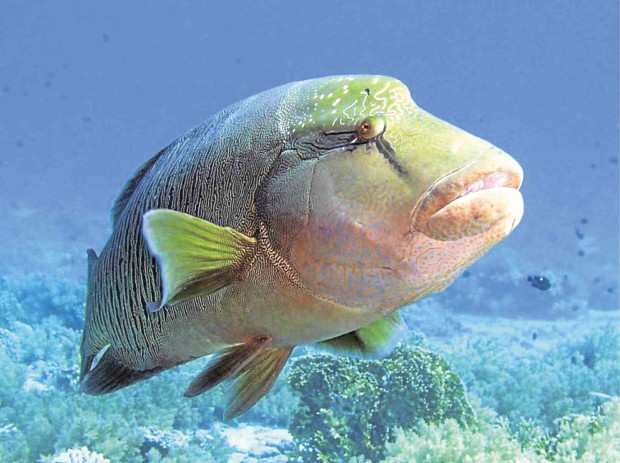Finding ‘mameng’: PH losing reef fishes

IN TROUBLED WATERS There are plenty of fish in the sea? Not anymore, or so says a study conducted by Haribon Foundation, which blamed their rapid decline in number to overexploitation and illegal fishing. Shown here is the humphead wrasse (“Cheilinus undulatus”), or the popular delicacy “mameng.” PATRYK KRZYZAK
The Philippines will lose at least 59 reef fish species, including the mameng, talakitok and maya-maya, in the next 15 to 25 years due to overharvesting and illegal fishing, according to a study conducted by the environmental group Haribon Foundation.
“The belief we once had that the sea is of unlimited resource is not true … The alarming loss of fishes is telling us that there’s not much time left for action,” Dr. Margarita N. Lavides, Haribon project manager, said in a statement released in time for World Oceans Day on Wednesday and Coral Triangle Day on Thursday.
Results of the study conducted by Haribon in partnership with Newcastle University UK were recently published in Plos One, a “peer-reviewed open access” scientific journal of the US-based Public Library of Science.
“We are slowly losing once common, wide-ranging, yet inherently large vulnerable reef fishes [that] have very important ecological roles,” Lavides said.
Path to extinction
Among the species vulnerable to extinction due to overpopulation, overharvesting and illegal fishing are the humphead wrasse (mameng), bumphead parrotfish (taungan), giant grouper (kugtong), African pompano (talakitok) and the mangrove red snapper (a type of maya-maya).
Mameng, a popular delicacy in most Asian restaurants, is priced at thousands of pesos apiece.
Ditto de la Rosa Jr., a research specialist at Haribon, cited the “often unnoticed” characteristics of the fishes, which could be a factor for the decrease in their populations.
“They grow large and age slowly [so] it also takes a long time for them to sexually mature,” De la Rosa said in a phone interview with the Inquirer. “Most of these fishes are caught prematurely so they are not given time to reproduce.”
He cited as an example the case of the lapu-lapu (grouper). “They are caught when they measure 30 centimeters—the size of a plate … so they are not able to produce eggs,” he said. “That’s the primary reason why they are getting extinct,”
The taungan, the largest type of parrotfish in the world, grows to at least 1.3 meters and has a life span of up to 40 years, while the mameng grows to at least 2 meters with a life span of up to 30 years.
Ecological effects
From 2012 to 2014, Haribon Foundation, Newcastle University and the Darwin Initiative 19-020 Project interviewed 2,655 fishermen around coral reefs. The face-
to-face interviews were conducted with local partners off Lanuza Bay in Surigao del Sur province, Danajon Bank in Bohol province and Honda Bay and Palawan State University in Palawan province, and the city agriculture office of Puerto Princesa City.
The study noted the decrease of several species of fish from as early as the 1950s, adversely affecting marine biodiversity and the immediate reduction in earnings of the fishermen.
Most of the disappearing species perform active roles in the maintenance of corals, according to Haribon.
The taungan helps the healthy growth of corals by eating and scraping algae and bacteria. The fish also feed on hard corals, consuming about 5 tons of reef carbonate every year. The reef carbonate turns into white sand.
The mameng helps regulate the population of poisonous crown-of-thorns starfish, which eat and ultimately destroy living corals.
The kugtong ensures balance among functional groups in coral reefs and sustains healthy fish populations by feeding on sick and old fish.
Short-term solutions
De la Rosa suggested possible “short-term solutions” to protect the reef fish species from extinction, including the passage of municipal ordinances or local legislative measures to be implemented by the mayors and their deputies.
He sought a review of the list of endangered species by the Convention on International Trade in Endangered Species of Wild Fauna and Flora (CITES), which categorizes only the humphead wrasse, as “vulnerable” and fails to include the African pompano and other fishes.
“We need to reassess so the whole world can see that these fishes are in danger of disappearing,” De la Rosa said. National law will be able to provide full protection to these species if listed by the CITES, he added.
The Philippines has a total of 2,248,400 hectares of coral reefs, regarded as the “rainforests of the seas.” It is home to some 2,500 species of fish, making it the epicenter of fish diversity in the world, even if it harbors only 9 percent of the total global coral reef area, Haribon said.
One of the most biodiverse ecosystems in the coastal and marine environment, the reefs provide ecosystem services that protect millions of Filipinos against storm surges, contribute to the enjoyment of residents, local and foreign tourists who flock to swim and dive, and provide food and jobs to millions who depend directly and indirectly to fisheries, it said.
Lavides described coral reefs as “good sentinels of global ocean change like the Philippine Eagle in our forests.”
“These losses we’ve recorded in the Philippines are reflective of unsustainable exploitation affecting this exceptionally species-rich ecosystem and region, but they mirror what is happening in ecosystems around the globe,” said Dr. Nicholas Polunin, professor of marine environmental science at Newcastle University UK and leader of the Darwin Initiative 19-020 Project.














